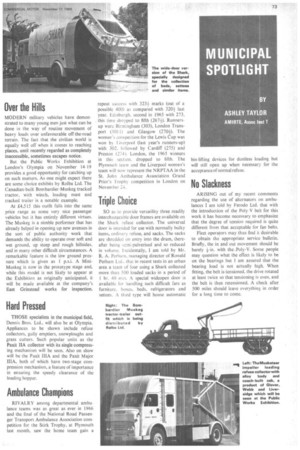Over the Hills
Page 75

If you've noticed an error in this article please click here to report it so we can fix it.
MODERN military vehicles have demonstrated to many young men just what can be done in the way of routine movement of heavy loads over unfavourable off-the-road terrain. The fact that the civilian world is equally well off when it comes to reaching places, until recently regarded as completely inaccessible, sometimes escapes notice.
But the Public Works Exhibition at London's Olympia on November 14-19 provides a good opportunity for catching up on such matters. As one might expect there are some choice exhibits by Rolba Ltd. The Canadian-built Bombardier-Muskeg tracked tractor, with winch, loading mast and tracked trailer is a notable example.
At £4,515 this outfit falls into the same price range as some very nice passenger vehicles but it has entirely different virtues. The Muskeg is a nimble performer that has already helped in opening up new avenues in the sort of public authority work that demands the ability to operate over soft and wet ground, up steep and rough hillsides, and in many other difficult circumstances. A remarkable feature is the low ground pressure which is given as 1 p.s.i. A MiniMuskeg is now in the prototype stage and, while this model is not likely to appear at the Exhibition as originally anticipated, it will be made available at the company's East Grinstead works for inspection.
Hard Pressed
THOSE specialists in the municipal field, Dennis Bros. Ltd., will also be at Olympia. Appliances to be shown include refuse collectors, gully emptiers, snowploughs and grass cutters. Such popular units as the Paxit IIA collector with its single compressing mechanism will be seen. Also on show will be the Paxit IIIA and the Paxit Major IIIA, both of which have two-stage compression mechanism, a feature of importance in ensuring the speedy clearance of the loading hopper.
Ambulance Champions
RIVALRY among departmental ambulance teams was as great as ever in 1966 and the final of the National Road Passenger Transport Ambulance Association competition for the Stirk Trophy. at Plymouth last month, saw the home team gain a
repeat success with 323; marks (out of a possible 400) as compared with 320+ last year. Edinburgh, second in 1965 with 273, . this time dropped to fifth (2674). Runnersup were Birmingham (303), London Transport (3014) and Glasgow (270+). The women's competition for the Lewis Cup was won by Liverpool (last year's runners-up) with 302. followed by Cardiff (275) and Preston (274). London, the 1965 winners in this section. dropped to fifth. The Plymouth team and the Liverpool women's team will now represent the NRPTAA in the St. John Ambulance Association Grand Prior's frophy competition in London on November 24.
Triple Choice
SO as to provide versatility three readily interchangeable door frames are available on the Shark refuse collector. The universal door is intended for use with normally bulky items, ordinary refuse, and sacks. The sacks are shredded on entry into the drum, thereafter being serni-pulverised and so reduced in volume. Incidentally, I am told by Mr. R. A. Perham. managing director of Ronald Perham Ltd.. that in recent tests in an urban area a team of four using a Shark collected more than 500 loaded sacks in a period of 1 hr. 40 min. A special wideopen door is available for handling such difficult fare as furniture, boxes, beds, refrigerators and settees. A third type will house automatic
bin-lifting devices for dustless loading but will still open up when necessary for the acceptance of normal refuse.
No Slackness
ARISING out of my recent comments regarding the use of alternators on ambulances I am told by Ferodo Ltd. that with the introduction of the Poly-V belt for this work it has become necessary to emphasize that the degree of tension required is quite different from that acceptable for fan belts.
Fleet operators may thus find it desirable to obtain the appropriate service bulletin. Briefly, the in and out movement should be barely Fin, with the.Poly-V. Some people may question what the effect is likely to be on the bearings but I am assured that the bearing load is not actually high. When fitting, the belt is tensioned, the drive rotated at least twice so that tensioning is even, and the belt is then retensioned. A check after 500 miles should leave everything in order for a long time to come.
































































































































